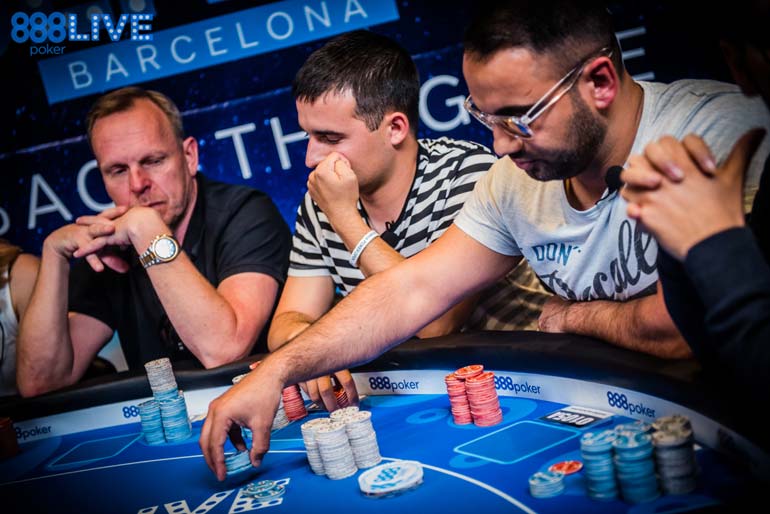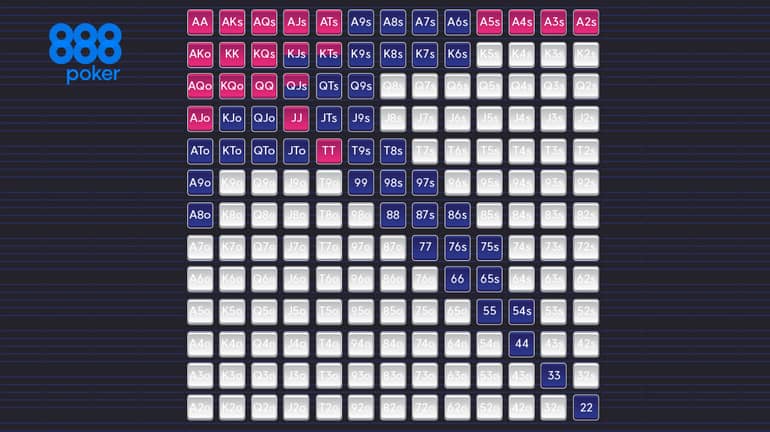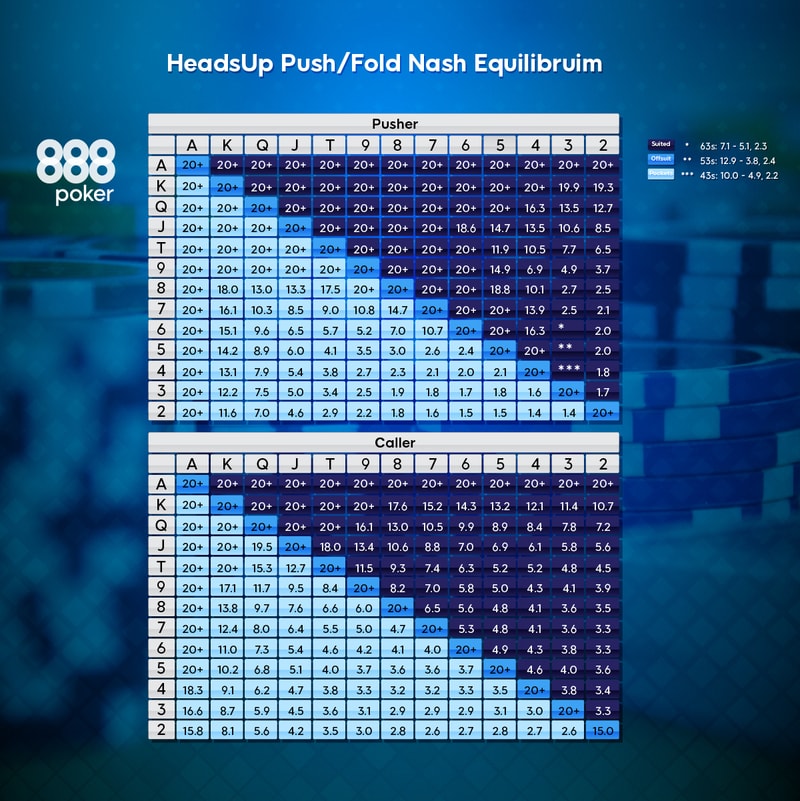The Nash Equilibrium is a game theory concept, which can undoubtedly be used in poker (as we’ll see in this article).
But its premise also applies to other areas outside of poker, such as economics and social sciences.
In essence, the Nash Theorem states that you would choose not to deviate from an initial course of action. You would take this action even if you knew your opponent’s strategy.
In other words, say two poker players knew each other’s strategies. They opted NOT to deviate from their initial strategy (because they could not derive any more profit or EV).
In this instance, the Nash Equilibrium is satisfied.
Table of Contents
GTO vs Nash Equilibrium
The popular term “GTO” has become commonplace in poker over the past few years. It stands for “game theory optimal”.
- GTO strategies help show players the best, ideal strategies to use versus other players who are playing equally optimally.
- So, the Nash Equilibrium and GTO (while not entirely synonymous) do operate along the same tangent.
If you want to learn more about GTO strategies for poker, check out this in-depth guide on the subject here:
https://www.888poker.com/magazine/strategy/beginners-guide-gto-poker
Profiting in Poker: Using the Nash Equilibrium
Say you put two poker players who were playing perfect GTO poker against each other. After enough hands, both players would have a profit of 0 (minus the rake).
Even by knowing their opponent’s strategy, they would choose not to change, which would prove the Nash equilibrium. Playing perfect poker would only let the luck of the cards determine who would be the winner. In a cash game, this process would even out over a long enough amount of time.
In practice, playing GTO poker allows room for profit based only on the mistakes that your opponent(s) make.
Playing perfect poker makes your plays unexploitable.
If your opponent is making mistakes, the Nash equilibrium will no longer be proven or applicable.
- As such, to maximise your expected value (EV), you can deviate from GTO.
- Use appropriate counter-strategies to those of your opponents.
In Summation:
- GTO strategy vs GTO strategy = 0 profit/loss from both players
- GTO strategy vs Exploitative strategy = profit to GTO player only due to exploitative player’s mistakes
- GTO deviation vs Exploitative strategy = higher profit margins yielded to GTO deviation opponent than if they used their baseline GTO strategy.
How to Apply the Nash Equilibrium to Poker
Poker is a fascinating game, especially if you analyse how players study versus how they typically play.

How to How to Apply the Nash Equilibrium to Poker
Aspiring amateurs and poker pros alike will often study GTO concepts and strategies to help improve their game.
But during gameplay, they will often play a more exploitative strategy for one of two reasons:
- Intentionally: to help yield higher profits against weaker opponents
- Unintentionally: they have not yet sufficiently memorised all the ins and outs of the Nash Equilibrium/GTO-based gameplay. This concept brings into effect the “humanisation” factor of one’s gameplay.
To increase potential profit margins, players should look to exploit strategies in their opponent’s gameplay. This goal should be paramount, regardless of what strategies someone is currently using,
To do so, players must first know what GTO strategies consist of to recognise these deviations.
Studying GTO poker concepts (along with the Nash equilibrium) have multiple benefits:
- It will help you plug your leaks. It can guarantee profit that will come in the long-term from your opponent’s mistakes.
- It will help you see how your opponent may be deviating from ideal gameplay strategies. This information will allow you to realise how to profit more fully from their actions.
Example of the Nash Equilibrium in Poker
ONE: This example demonstrates the Nash equilibrium in practice in relation to preflop strategies.
For example -
- According to GTO strategy, when action is folded to the button, he should raise 43.3% of his hand range. This play assumes that the button’s open size is 2.5bb, and there are no straddles or antes.
- To combat this GTO strategy, if the small blind folds, the BB should defend about 56.8% of the time. (The BB should 3bet13.4% of the time and call43.4% of the time).
 BB Defence vs BTN Open - Purple: Re-raise (3bet) range, Blue: Cold calling range
BB Defence vs BTN Open - Purple: Re-raise (3bet) range, Blue: Cold calling range
Let’s assume GTO-based strategies are continued post-flop. In the long-run, neither of these two players will show a profit in this poker game.
Even if one’s preflop strategy is exposed to the other player, neither player will alter or change their poker strategy.
They are playing perfect preflop poker and have reached the state of being in the Nash equilibrium.
TWO: Now, imagine that there is a tight but competent opponent in the big blind!
Say the button knows that the big blind is on the tighter side. Perhaps the button player will now opt to open 70%+ of hands to show a higher overall profit.
THREE: Say, to combat this, the big blind realises that the button is opening a broader range. The BB decides to 3bet more liberally and defend a wider range of hands overall.
| Now we have two players deviating from the perfect/GTO/unexploitable preflop ranges. They are both accounting for the changes in their opponents’ preflop strategy that they have witnessed. |
While both players’ strategies help combat that of the other, note that the Nash equilibrium is not proven in this case. This scenario does not represent the ideal, baseline, initial preflop strategy for “perfect poker”.
They are deviating from their initial course of action.
FOUR: Say the player on the button does not want to face as much pressure from their opponent’s high frequency of 3bets. He may decide to return to their baseline GTO opening strategy of raising-first-in with 43.3% of hands for 2.5x.
FIVE: Seeing that the button has now reduced their open frequency, the big blind decides to reducetheir 3-betting frequency. Also, they choose not to defend as many hands.
At this point, we have reached the perfect preflop GTO vs GTO ranges.
Thus, we are satisfying the Nash equilibrium once again.
Poker Tournaments and the Nash Equilibrium
One of the most common uses of the Nash equilibrium comes in shoving/calling ranges in tournaments. Imagine action folds to you in the small blind. The player in the big blind is a world-class GTO player.
You don’t want to make mistakes. Your opponent will surely find a profit from the times that you do.
| So, you want a solid push-or-fold strategy that allows you to know how you should play your hands based on the stack size you have. |
As such, Nash charts for push/fold situations can help players with their gameplay strategies. These charts can help, especially for short stack play in the later parts of poker tournaments.
To learn more about these Nash charts, check out this link:
https://www.888poker.com/magazine/strategy/push-fold-charts
 Push/Fold Nash Equilibrium Heads-Up Chart
Push/Fold Nash Equilibrium Heads-Up Chart
These charts are most applicable for the later positions of a poker game (small blind and button).
For how to play a solid push-or-fold strategy from other positions when short-stacked, check out the app SnapShove.
Taking Your Game to the Next Level
Let’s be honest for a second. Understanding this article won’t necessarily provide immediate help to influence your gameplay positively.
Understanding the Nash equilibrium concept will help you realise how crucial it is to improve your game and study GTO strategies.
Need help taking the next step up with your poker abilities?
We recommend checking out the following strategy article.
It sheds light on 20 Advanced Poker Tips that will help put you on the right path to improving your game:
https://www.888poker.com/magazine/strategy/20-advanced-poker-tips
Nash Equilibrium Summary
Understanding the Nash equilibrium and its relation to GTO poker will become ever more critical as poker evolves.
With the skill gap constantly narrowing between players, it’s essential to study GTO strategies as a baseline. That way, you can know what your default plays should be and how to deviate from them.
Learn to maximise EV when exploitable tendencies are presented to you by other players at the table.

